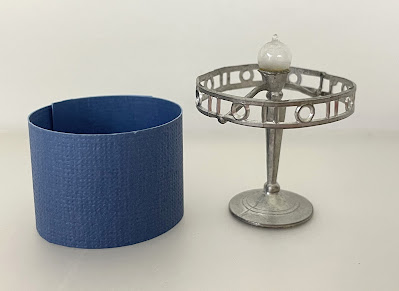This dollhouse was produced in 1934, the last year of production for the A. Schoenhut Company of Philadelphia, Pennsylvania. It has suffered some water damage, is missing the chimney, and was missing the door and two windows when it arrived. I will get around to making a chimney one day. I made the door....and then installed it the wrong way, that's why the door knob is on the right side. I "borrowed" two windows from the side of another small Schoenhut, because in my Dollhouse Village, having front windows is more important than having side windows!
This illustration is from a 1934 dealer's catalogue and appears in a soft cover book Dollhouses and Dollhouse Furniture (Manufactured by A. Schoenhut Company Philadelphia, Pa. 1917-1934) compiled by Margaret Whitton. Notice that it came with lights in each room and a removable back cover. This illustration shows the extension on the right side, while the extension on my house is on the left.
This illustration of the entire page might explain why. Notice that all of the houses are facing left. It is possible that the graphic designer flipped the image to create a more visually pleasing composition.
A cute little family has moved in to "No.208E". I might know their names by the end of this post.
The house has 5 rooms....two bedrooms, a kitchen, dining room and living room. No bathroom, and no outhouse in sight.
The living room is furnished in German Red-stain furniture. The seating pieces and the clock can be found in International Dollhouses and Accessories by Zillner and Cooper, page 214. This book, published in1998, indicates the maker of German Red-stain furniture was unknown at that time. Twenty-six years later we are still trying to discover that information.
The lamp base is incised Germany; it came without the celluloid shade. I fashioned one of textured paper, not the same as the original but it works for me.
The dining room has a Schoenhut dining room table set and buffet from their 1931 production line.
The maker of the hutch is unknown, possibly a German or Japanese import.
The kitchen is furnished in Schoenhut with a Kage fridge.
The stove, sink, table and chairs are Schoenhut from 1932. The fridge is Kage from the late 1940s.
I found this wonderful handmade crazy-quilt on Ebay and thought it was just perfect for the Kage bed.

.jpg)















Beautifully done. I enjoy reading and viewing your posts and all of the history. You have a good eye!
ReplyDelete